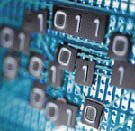Using Current Technology To Prepare For Quantum Computing
 “If we use the environment in the process,” explains Almut Beige, “we don’t need to control everything.” Dr. Beige and two students working with her at Imperial College London, Jeremy Metz and Michael Trupke, have devised a system of robust quantum entangles with the help of macroscopic quantum jumps. “If we use the environment in the process,” explains Almut Beige, “we don’t need to control everything.” Dr. Beige and two students working with her at Imperial College London, Jeremy Metz and Michael Trupke, have devised a system of robust quantum entangles with the help of macroscopic quantum jumps.
The system, which posits a tunnel set-up and simple detection, could be tested relatively soon, since it relies on current technology.
The system, which could be used to prepare entanglement for quantum computing, is described in a Letter, “Robust Entanglement through Macroscopic Quantum Jumps,” published July 27 in Physical Review Letters.
“The idea,” Beige tells PhysOrg.com, “is to build an optical cavity and trap atoms in it.” She continues: “We can use optical technology we already have. By mounting little cavities on atom chips made from fibers, it is possible to measure the photons coming out.” And when they stop coming out, when the phase is dark, that means the entangled state is prepared.
“Detection is much simpler with this system,” explains Beige. “In other configurations you have to detect a single photon to know that the entanglement works. This is very difficult. It’s difficult to see what the atoms are actually doing. With this system, you either see a lot of photons, or none.”
Beige and her students have developed the system so that it would work in macroscopic time. The system works by trapping the atoms in an optical cavity and then using a laser to create a configuration that emits photons. However, there is a state when the system becomes dark and stops emitting photons. This is when the macro quantum jump takes place. “Instead of the fluorescence going down a little bit,” Beige says, “it stops completely. This constitutes a measurement whether or not the system sees the laser.”
Another advantage of the system proposed by Beige, Metz and Trupke is that the system doesn’t have to be driven by the experimenters to create the entanglement. “The system does it automatically,” explains Beige. “With the environmental process, you know as soon as the system goes dark that the entanglement is prepared.”
She continues: “Another big advantage is that we are not relying on extremely good set ups, so even with moderately good set ups we would get good fidelities.” How good? Well, Beige thinks that up to 90 per cent fidelity could be achieved with this atom-cavity system, as opposed to almost 50 per cent with current proposals. The reason: “This system is not as dependent on perfect set up and on individual photon detection.”
The optical cavity system would be used to prepare quantum entangled states for preparation in quantum computing. The idea of creating entangled states beforehand means that they do not have to be prepared immediately before. “It’s a way to prepare highly entangled states, ready for quantum computing.”
The simplicity of the system, and its easy detection of entanglement, makes it less expensive, and more practicable using technology already developed. “Several groups are working on entanglement,” Beige says, “and we hope that maybe next year someone can do what we have proposed.”
Source: PhysOrg
|